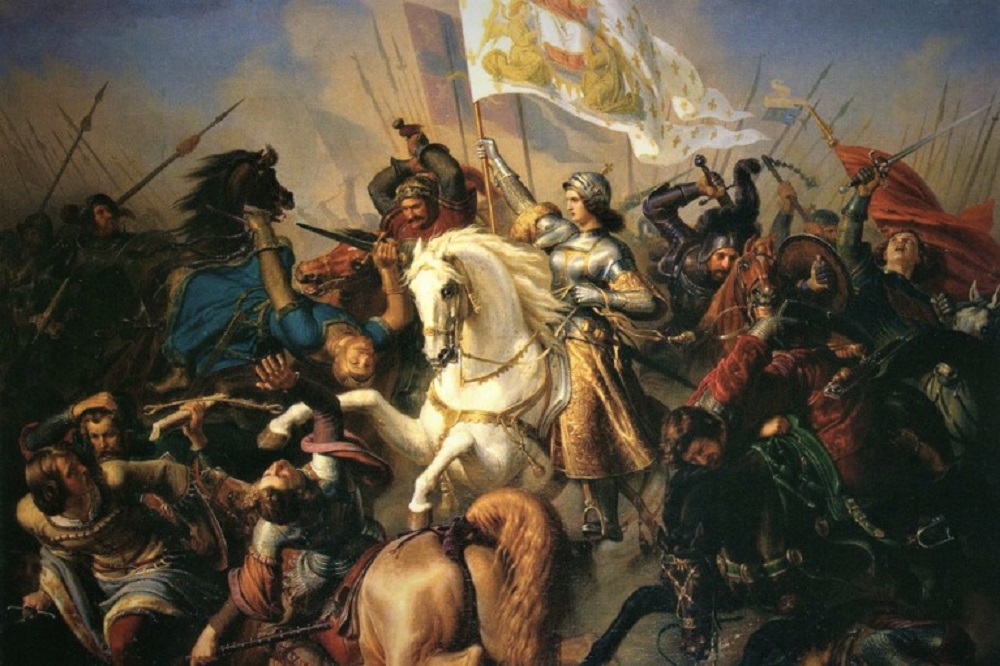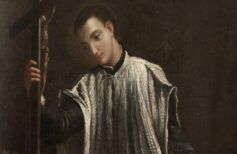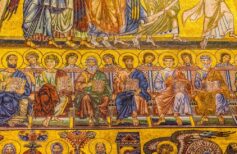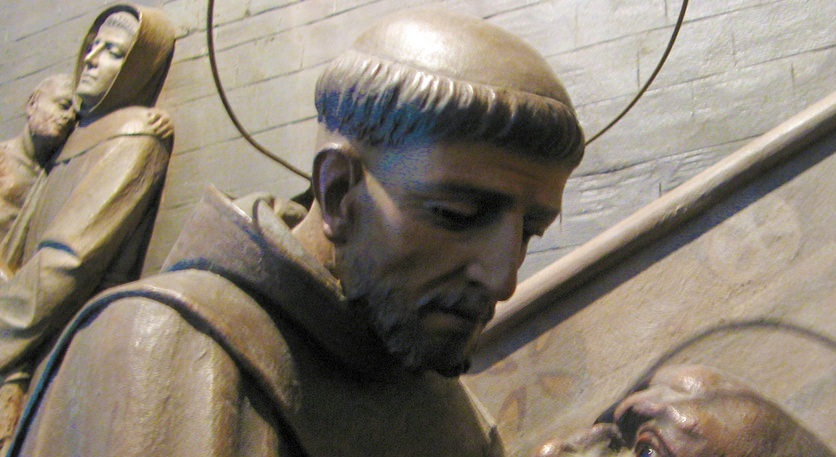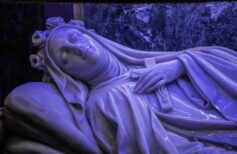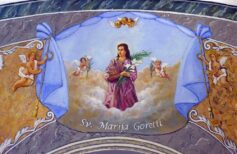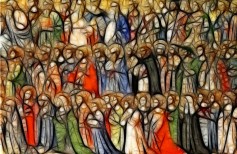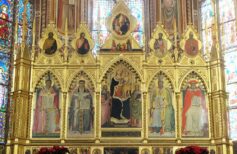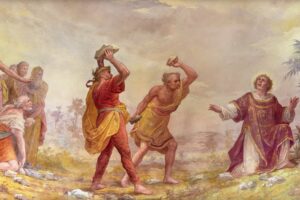Joan of Arc, also known as the Flea of Orléans is a French national heroine. Her figure inspired the devotion of her contemporaries, and her tragic end made her a saint still loved and venerated by the Catholic Church today.
What do we really know about Saint Joan of Arc? Let’s start by saying that it is rightfully among the ten Christian Women who changed the Church and the world. Remembered among the saints not only for her spiritual strength but also for having held the sword in the name of faith. And what’s even more surprising considering she was just a young woman.

Books have been written about her, films have been made about her, which have now brought to light one aspect of her controversial figure. Controversial, because today we know of her that she was a very young peasant woman called by God to sustain a test of courage and faith that many mature men and military navigated would not be able to carry forward. But in her time, when her brief and tragic human affair was consummated, everything and the opposite of everything was said about her. Beloved some a saint, she ended up being accused of witchcraft and, just nineteen, knew death at the stake.
Nevertheless, in 1909 Pope Pius X beatified her, but already before him Pope Callistus III in 1456 had declared null and void the process that had led to her death and had rehabilitated her. In 1920 Joan was proclaimed a saint by the will of Benedict XV and from 1922 is among other things patroness of France. Pope Emeritus Benedict XVI also expressed his interest in this young saint, in the general audience on 26 January 2011, and compared her to Saint Catherine of Siena, patroness of Italy.
How did an alleged witch become a saint? To understand this apparent contradiction we must immerse ourselves in the time and historical context in which Joan lived, fought and died. A time in which, more than in others, the human being knew how to rise to very high peaks of genius and artistic expression, and at the same time showed unsustainable barbarism and ferocity. Joan’s story is indeed only at the beginning of the Renaissance, but this contrast between spiritual, intellectual and artistic elevation, and cruelty, the little value of human life, was already well outlined.
Let us try to understand better the story of Joan of Arc, the holy warrior, “the Flea of Orléans”, as she was known to her contemporaries.
The story of Joan of Arc
We have mentioned the time when Saint Joan of Arc lived and died, a period between the end of the Middle Ages and the beginning of the Renaissance. In particular, a preponderant role in Joan’s life was played by the so-called Hundred Years’ War, a conflict that between 1337 and 1453 saw the Kingdom of England and the Kingdom of France opposed. To this, we add that the Western Schism between 1378 and 1417 had torn the Western Church with a clash between popes and antipopes for the control of the pontifical threshold.
It was in the setting of this long and terrible war that in 1412 Joan was born in Domrémy, in the north-east of France. Joan was born into a humble family of peasants. Ignorant and illiterate, she demonstrated a natural predisposition to help the poor and needy from an early age. Her childhood was characterised by charity, mercy and an aptitude for sacrifice.
At thirteen she began to say she was visited by Saint Michael the Archangel, Saint Catherine and Saint Margaret. These three beneficent presences spoke to them with heavenly voices, sometimes manifesting themselves with flashes and true visions.
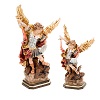
When in 1429 the British, aided by their Burgundian allies, were about to conquer Orléans, a city of inestimable economic and strategic value to the French, rumours ordered Joan to leave the house of her parents and go to the aid of Charles Valois, Dauphin heir to the throne of France (he would later rise to the throne under the name of Charles VII).
Joan, who was seventeen years old at the time and about to be forced into marriage, convinced her parents of the importance of her mission and managed to get to meet first the captain of the Vaucouleurs stronghold, then, the latter convinced of his good faith, the Dolphin himself in the castle of Chinon.
Charles did not immediately trust this strange girl who claimed to have been sent by God to save France and her right to the throne.
He subjected her to many thorough investigations, conducted by distinguished theologians and high-ranking ecclesiastics, first at Chinon, then at Poitiers.
Finally convinced, Charles granted her the task of accompanying the military expedition departing for Orléans. Although she had not been given any military commission, Joan began to impose an almost monastic lifestyle on the soldiers, driving out prostitutes, prohibiting looting and violence and even blasphemy. She also decreed that they often confessed and that twice a day they would gather in common prayer at the foot of the white banner depicting God granting His blessing to the cornflower symbol of the French monarchy, with the archangels Michael and Gabriel at their sides.
Joan rode a white horse, wore armour and carried the sword at her side, like a soldier. Soon everyone, soldiers and civilians, began to call her “Jeanne la Pucelle”, Joan the Maid. In addition to the travelling soldiers, many volunteers joined her, inspired by her figure and fervour.

At Orléans, now exhausted by the long siege, John the Bastard was dealing with the surrender with Philip the Good, Duke of Burgundy and ally of the British. Joan came to the city carrying food and reinforcements for the exhausted troops.
Although the Bastard had warned her not to take military action, the same evening Joan took to the stands and, addressing the British troops, ordered them to surrender and leave, receiving in response only insults and threats. After days of fighting, during which Joan fought on the front lines, encouraging the French soldiers with her example, and receiving many wounds, the British were forced to retreat.
After the victory of Orléans Joan continued her march through France, bringing another resounding victory to Patay and thus paving the way for the consecration of King Charles VII at Reims.
Here begins the descending parable of Joan. Having won the war, at least for the time being, and brought ‘her’ King to the throne, she seems to have lost all reason to go on. However, she continued to oppose the British and Burgundians on French territory, ignoring the envy and growing hostility of the court towards her. The people who met her looked at her like a saint sent from heaven and asked for miracles.
It was at Margny on 23 May 1430 that she was finally captured by the Burgundians and, later, ceded for a conspicuous ransom to the British. Charles VII never attempted to free her, nor did he offer a ransom in turn, leaving her to her fate. The imprisonment in the hands of the British was very harsh, and in the end, Joan was brought to trial “strongly suspected of numerous crimes alluding to heresy”.
Trial and death at the stake
The trial of Joan of Arc was a farce from its earliest stages. The University of Paris, a depository of civil and ecclesiastical jurisprudence, was totally subservient to the English, who had already condemned Joan and wanted her dead. Her death would not only have freed them from a dangerous symbol much loved in France but would have discredited the authority of Charles VII.
She was tried for heresy by an inquisitorial tribunal, whose judgment Joan never accepted. She was convicted on false charges and forced to abjure. Even in prison, Joan continued to receive visits from her heavenly friends, who reassured her by exhorting her to accept her martyrdom.
She was burned alive in Rouen on 30 May 1431. She asked a priest to keep a cross high before the stake, so that she could die looking at Jesus Crucified, invoking His name.

Review of the judgment
Only after the French had completed the reconquest of all of France, in 1455, did Pope Callistus III order a review of the trial of Joan of Arc. The following year the trial was declared null and void and Joan was declared completely innocent on charges of heresy.
In 1909 Pope Pius X beatified her.
In 1920 she was canonised by Pope Benedict XV. Since 1922 Joan has been the patron saint of France.
Saint Joan of Arc like Saint Catherine of Siena
We have already mentioned how Pope Benedict XVI compared Joan of Arc to Saint Catherine of Siena, patroness of Italy and Europe. Both were young girls, and when they received their call, both were born from humble families and chose to serve God, not in the convent, but on the battlefield one, at the service of the poor and the sick the other.
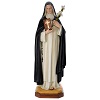
In addition, both Joan of Arc and Catherine lived in a period of profound crisis for the Church, with the Schism of the West and the wars that ravaged Europe. While Joan struggled to bring Charles VII to the throne, Catherine pledged herself against the Anti-Papal League and tried to convince Pope Gregory XI to return to Rome from Avignon.
Of them, Pope Benedict says: “We could approach them (Joan of Arc and Catherine of Siena) to the Holy women who remained on Calvary, close to the crucified Jesus and Mary his Mother, while the Apostles had fled and Peter himself had denied him three times”.
Great women, who have made faith and service to God the ultimate goal of their lives and have not stopped even in the face of martyrdom, in the case of Joan, and suffering in that of Catherine.

